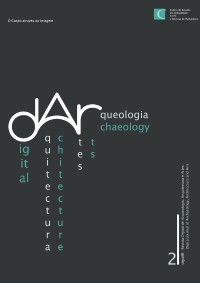Please use this identifier to cite or link to this item:
https://hdl.handle.net/10316.2/39301| DC Field | Value | Language |
|---|---|---|
| dc.contributor.author | Antunes, Joana | - |
| dc.date.accessioned | 2016-09-01T23:02:50Z | |
| dc.date.accessioned | 2020-09-16T08:29:46Z | - |
| dc.date.available | 2016-09-01T23:02:50Z | |
| dc.date.available | 2020-09-16T08:29:46Z | - |
| dc.date.issued | 2015 | - |
| dc.identifier.issn | 2182-844X (digital) | - |
| dc.identifier.uri | https://hdl.handle.net/10316.2/39301 | - |
| dc.description.abstract | The margins of medieval art, at its extreme of cronological and typological length, have been perceived as places of transgression. This transgressive nature, whether spontaneous or premeditated, is frequently reinforced by the depiction of the human body which, in its uncomely gestures and frequent dehumanization, seems to underline a stable separation between centre and margin. Accepting the body and its depiction as recipiente of visually codified tensions, I will try to present the concept of margination as a process that imbues an image with marginality and alterity without forcing its physical segregation from the space and meaningful context to which it belongs. Departing from the analysis of illuminated manuscripts - whose nature prompted an early and clear articulation between centre and margins, text and image - , and the way medieval man depicted himself at liminal situations, this paper aims at the reflexion on the place of margins in medieval art and the recognition of its polissemy, and its symbolical and semantic potential. | eng |
| dc.description.abstract | As margens da arte medieval, no limite possível da sua elasticidade cronológica e tipológica, têm sido lidas à luz de uma transgressividade ora espontânea, ora premeditada, que encontra na representação do corpo humano, da sua aparência, da sua gestualidade, da sua frequente desumanização, o indicador aparente de uma separação estável entre centro e margem. Reconhecendo o corpo e a sua representação como recipientes de tensões visualmente codificadas, procurar-se-á apresentar a marginação enquanto processo que torna intrinsecamente marginal e dota de alteridade uma imagem sem que ela sofra um radical processo de separação do entorno físico que lhe confere sentido. Partindo do manuscrito iluminado, suporte cuja natureza mais cedo propiciou uma clara articulação entre centro e margens, texto e imagem, objectiva-se a reflexão em torno do lugar da margem na arte medieval para um entendimento da sua polissemia, do seu potencial semântico e simbólico, através da forma como o homem medieval se representou a si próprio em situação de liminaridade. | por |
| dc.language.iso | por | - |
| dc.publisher | Centro de Estudos em Arqueologia, Artes e Ciências do Património | - |
| dc.rights | open access | - |
| dc.subject | Corporeity | eng |
| dc.subject | Margination | eng |
| dc.subject | Transgression | eng |
| dc.subject | Corporeidade | por |
| dc.subject | Marginação | por |
| dc.subject | Transgressão | por |
| dc.title | Corpos marginados na arte medieval | por |
| dc.type | article | - |
| uc.publication.collection | digitAR nº 2 | - |
| uc.publication.firstPage | 87 | - |
| uc.publication.issue | 2 | - |
| uc.publication.lastPage | 121 | - |
| uc.publication.location | Coimbra | - |
| uc.publication.journalTitle | digitAR: Revista Digital de Arqueologia, Arquitectura e Artes | - |
| dc.identifier.doi | 10.14195/2182-844X_2_6 | - |
| uc.publication.section | II - Entre deuses e demónios | - |
| uc.publication.digCollection | IP | - |
| uc.publication.digCollection | B1 | - |
| uc.publication.orderno | 8 | - |
| uc.publication.area | Artes e Humanidades | - |
| uc.publication.manifest | https://dl.uc.pt/json/iiif/10316.2/39301/216459/manifest?manifest=/json/iiif/10316.2/39301/216459/manifest | - |
| uc.publication.thumbnail | https://dl.uc.pt/retrieve/11259539 | - |
| uc.itemId | 71412 | - |
| uc.thumbnail.uri | https://dl.uc.pt/iiif-imgsrv/11259466/dl!3!16!93!64!169364227822936706917176645803990611405 | - |
| item.grantfulltext | open | - |
| item.fulltext | With Fulltext | - |
| Appears in Collections: | digitAR: Revista Digital de Arqueologia, Arquitectura e Artes | |
Files in This Item:
| File | Description | Size | Format | |
|---|---|---|---|---|
| corpos_marginados_na_arte_medieval.pdf | 4.59 MB | Adobe PDF |  |
Items in DSpace are protected by copyright, with all rights reserved, unless otherwise indicated.
